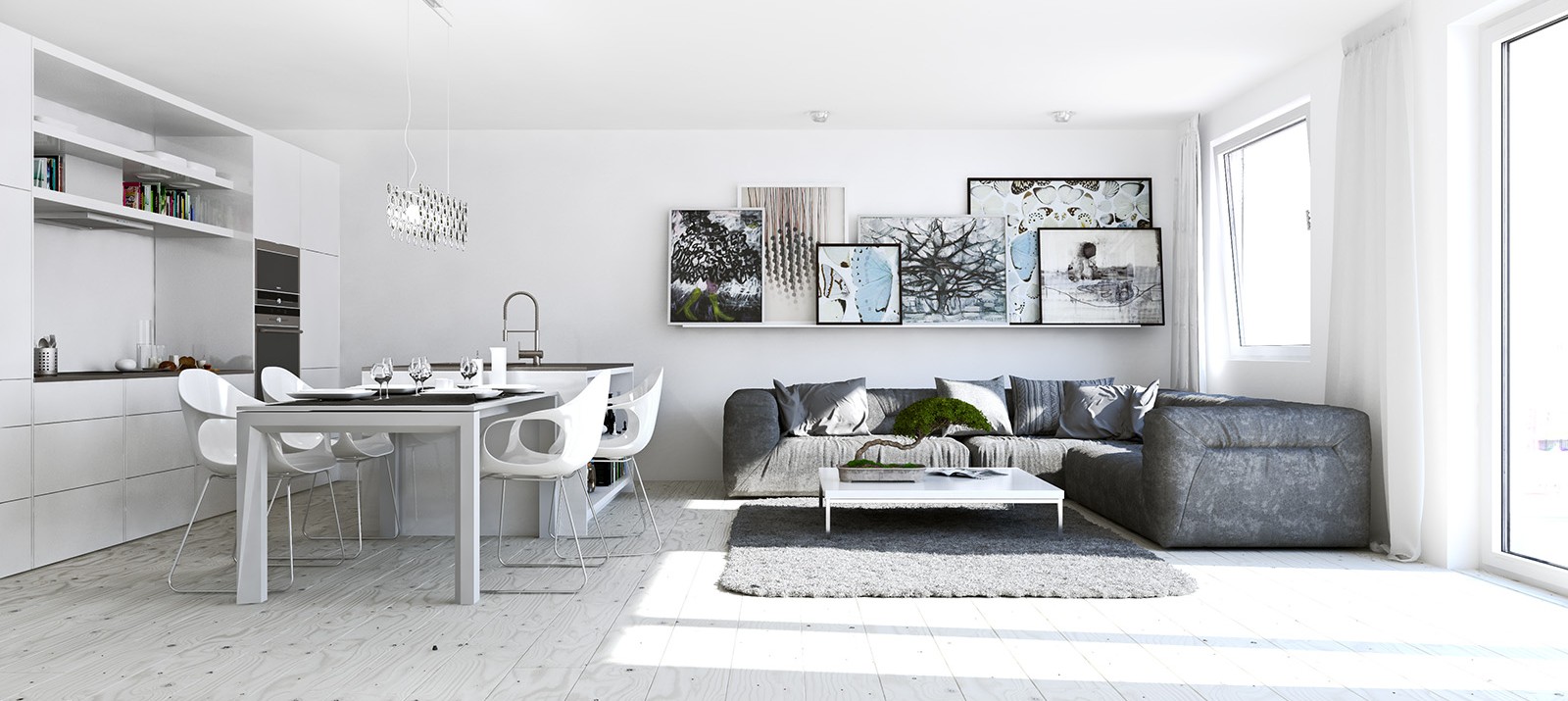After a long commute on the subway, standing between a grandmother with shopping bags and a burly guy playing Threes!, all you want is a place to relax. Unfortunately, if you live in a studio where your sleeping, eating, and working spaces overlap, your home can feel as crowded as public transit. Especially if you live with your significant other (by the way, here’s how to live happily with your S.O. in a tiny apartment).
One of the biggest challenges of studio apartments is deciding how to multiply rooms when you only have one. You could hire an incredible design firm to build a levitating bed, vanishing dining room, and pop-out kitchen like YO! Home’s.
Or you could implement a few of these simpler, cheaper tricks to create multiple living areas in your studio apartment. As much as we’d love to see a video of your YO! Home, we recommend the latter.
Why Is There a Need to Divide a Studio Apartment?
1. Creating Privacy: Dividing a studio apartment into separate zones can provide a sense of Privacy often lacking in open-plan living. This is particularly important for activities such as sleeping or working, where a defined space can help maintain focus and comfort.
2. Improving Organization: Establishing designated areas for different activities helps keep the apartment organized and tidy. It prevents the entire space from becoming cluttered and ensures that each zone serves a specific purpose, making daily routines more efficient.
3. Enhancing Functionality: By dividing the apartment, you can optimize the functionality of each area. For example, creating a separate kitchen or dining area allows for a more practical cooking and eating space, while a distinct sleeping area can be made more comfortable and restful.
4. Aesthetic Appeal: Dividing a studio apartment can enhance visual appeal by creating a more structured and harmonious layout. Using furniture, screens, or curtains to separate areas can add depth and dimension to the space, making it more inviting and stylish.
5. Better Use of Space: Properly dividing the apartment allows more efficient use of the available space. It helps maximize every square foot by ensuring that each area is used to its full potential, accommodating different activities without overcrowding.
Dividing a studio apartment is essential to address common challenges and improve the overall living experience.
Common Challenges of Studio Apartments
1. Limited Space: Studio apartments typically offer a single room that combines the living, sleeping, and kitchen areas, making it challenging to allocate enough space for all your needs. This compact layout requires efficient use of every square foot to ensure Functionality without feeling cramped.
2. Lack of Privacy: A studio apartment’s open-plan design means there’s little separation between different living areas. This can make it difficult to find Privacy, especially if you’re sharing the space with a partner or roommate.
3. Storage Issues: With limited closet and cabinet space, finding adequate storage can be a significant challenge in a studio apartment. Keeping belongings organized and out of sight requires creative storage solutions and minimalistic living.
4. Noise Control: The lack of physical barriers can lead to noise issues, as sounds from the kitchen, living area, and entryway can easily travel throughout the space. This can be particularly disruptive if you’re trying to sleep or work in the same room where other activities occur.
5. Defining Separate Zones: Creating distinct areas for different activities, such as sleeping, dining, working, and relaxing, can be difficult in a studio apartment. Clear boundaries make the space more manageable, affecting both Functionality and aesthetics.
DIY Ideas
1. Custom Shelving Units:
Building custom shelving units tailored to your studio apartment’s dimensions can optimize vertical space and offer much-needed storage.
These shelves can be designed to fit into corners or above existing furniture, providing additional areas for books, plants, and decorative items.
Using reclaimed wood or other materials, you can create unique, eco-friendly storage solutions that enhance the apartment’s aesthetic.
2. Repurposed Furniture:
Breathing new life into old furniture can be economical and creative. For example, an old ladder can be sanded and painted to become a rustic bookshelf or towel rack.
Vintage suitcases can be stacked to create a unique nightstand with concealed storage.
Repurposing furniture saves money and adds a personalized touch to your space.
3. Pegboard Walls:
Installing pegboards on one or more walls creates highly versatile storage options. Pegboards can be painted to match your decor and customized with hooks, shelves, and baskets.
They are ideal for organizing kitchen utensils, craft supplies, or office materials.
The flexibility of pegboards allows you to rearrange items as your needs change, making them a dynamic storage solution.
4. For movie buffs: Install a projector screen.
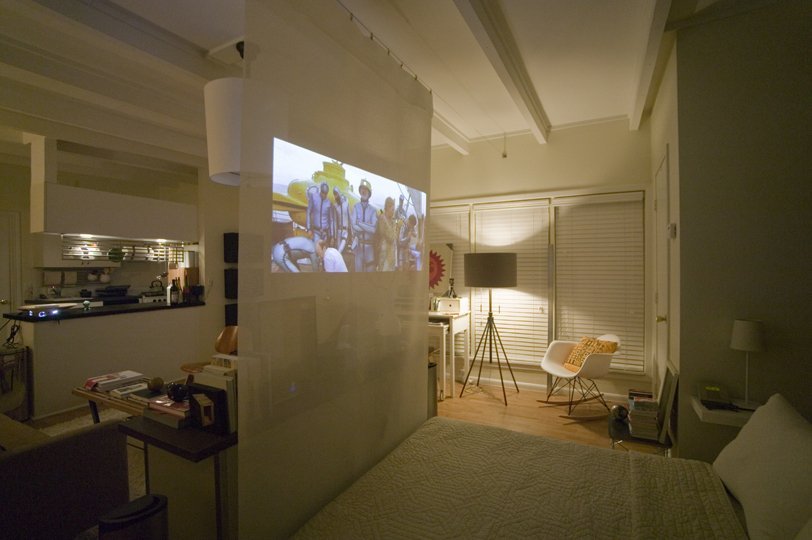
When most people think of essential living spaces, they probably list dining area, bedroom, and study or lounge. Houstonite Chris Nguyen, however, wanted a personal home theater, so he added a projection screen to the foot of his bed. The installation is simpler than you might expect, and the sheer panel allows light to pass through, keeping the small area open.
Creative Room Dividers
1. Curtain Partitions:
Using curtains to divide different areas of your studio apartment is practical and stylish. Curtains can be easily installed on ceiling tracks or tension rods, allowing you to create temporary or semi-permanent partitions.
Choose fabrics that complement your overall decor, and consider using sheer materials to allow light to filter through while still providing separation.
2. Bookshelf Dividers:
Tall, open-back bookshelves can serve as practical room dividers, providing storage and separation without blocking light.
Place a bookshelf between the living and sleeping areas to create a sense of distinct zones. Fill the shelves with books, plants, and decorative items to personalize the space and make it more cohesive.
3. Sliding Doors:
Sliding or barn doors can add a sophisticated touch to your apartment while serving as functional room dividers. These doors are space-efficient since they slide along tracks rather than swinging open.
They can be used to separate the bedroom from the living area or to create a private workspace. Sliding doors come in various styles and materials, from rustic wood to sleek glass, offering privacy and aesthetic appeal.
4. Buy a bar cart.
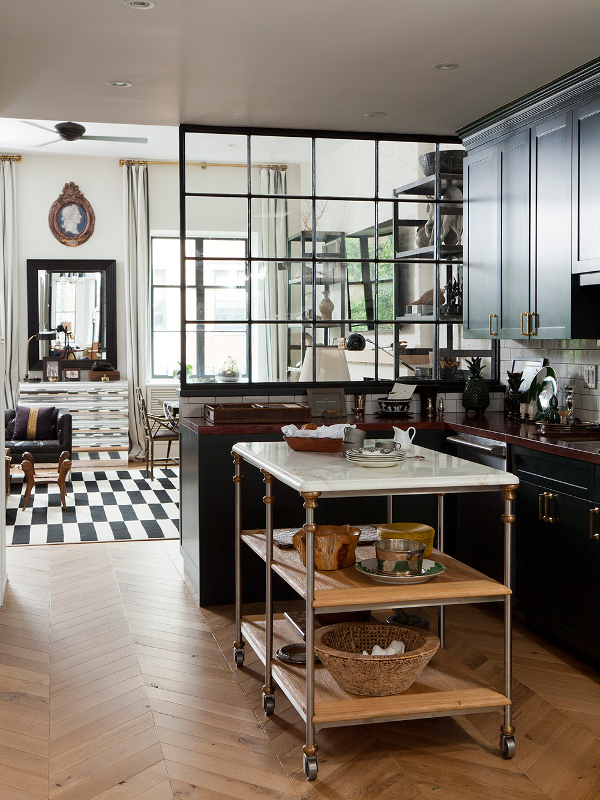
You don’t need a separate room for your kitchen to create a separate kitchen. Use a bar cart to divide the area organically and add valuable counter and storage space for your baking and boiling endeavors.
A bar cart is also an economical solution in every sense of the word. Many bar carts only occupy a couple of square feet, and you can find inexpensive options just about anywhere. Including IKEA, which sells a $29.99 RÅSKOG utility cart that you can easily hack into a bar cart.
Decorative Strategies
1. Accent Walls:
Creating an accent wall with paint or wallpaper can add depth and interest to your studio apartment. Choose a bold color or an interesting pattern to highlight a specific area, such as behind the bed or the dining table.
An accent wall can help define spaces and serve as a focal point, drawing the eye and making the apartment feel more dynamic.
2. Statement Rugs:
Rugs are potent tools for delineating different zones within a studio apartment. A bright, patterned rug can anchor the living area, while a softer, neutral rug can define the sleeping space.
Rugs add warmth and texture, making each zone feel distinct and comfortable.
3. Artwork and Mirrors:
Strategically placing artwork and mirrors can enhance your studio apartment’s visual appeal and functionality.
Mirrors reflect light and create the illusion of more space, making the apartment feel more extensive and more open.
Grouping smaller pieces of artwork into a gallery wall can add personality and charm while providing visual separation between areas.
4. Put your couch at the foot of your bed.
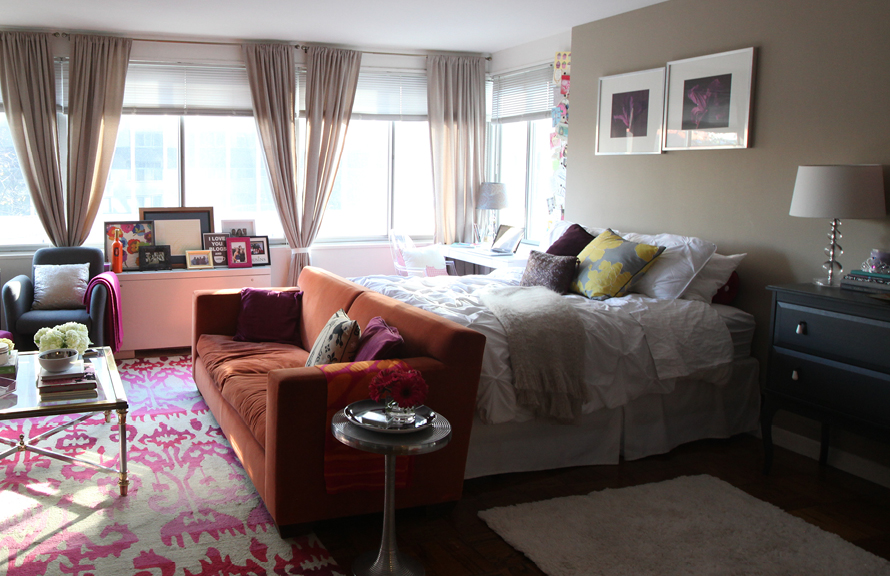
Separating your living areas doesn’t get easier than this trick, which works for almost any studio apartment. Set your couch at the foot of your bed so that your back faces your sleeping area whenever you’re seated. With or without an additional physical barrier, the psychological division is clear.
5. Think outside the wall with bookshelves.
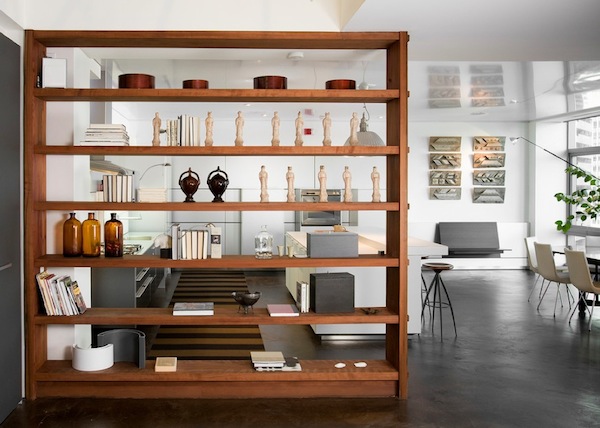
When one of your goals is to maximize space, the more practical a solution is, the better. Set bookshelves perpendicular to a wall to divide living areas and add valuable storage space in your small apartment. The bookshelves don’t have to stretch to the ceiling, but for the sake of illusion and the extra room, go tall.
6. Think thin walls, as in curtains.
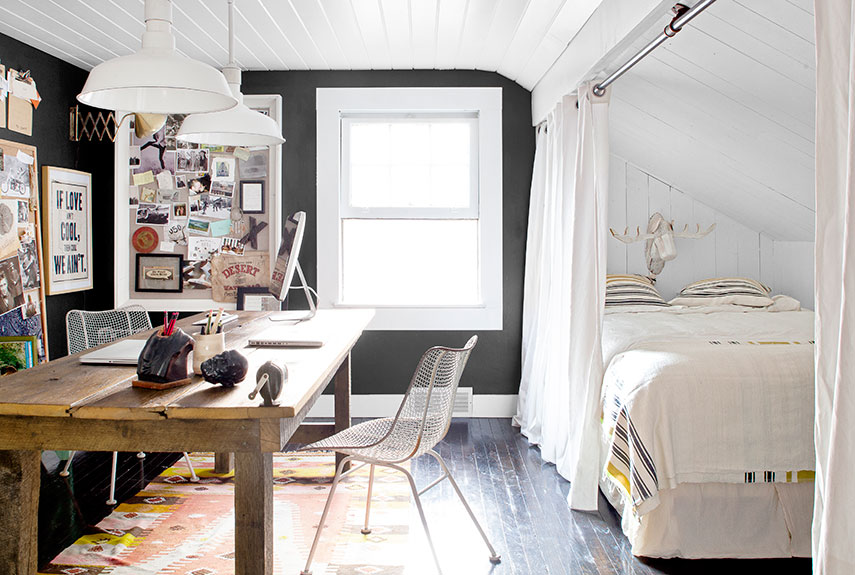
In a studio, like in any tiny apartment, every square inch counts. So if you want to physically separate your sleeping quarters, choose curtains.
When extended, curtains give you plenty of privacy yet take up millimeters of space. When you’re ready to get out of bed and expand the room, all you have to do is slide them out of your way with one hand.
Oh, and if you lack carpentry skills, don’t worry. A rod and fabric couldn’t be easier to hang.
7. Color-coordinate each living area.
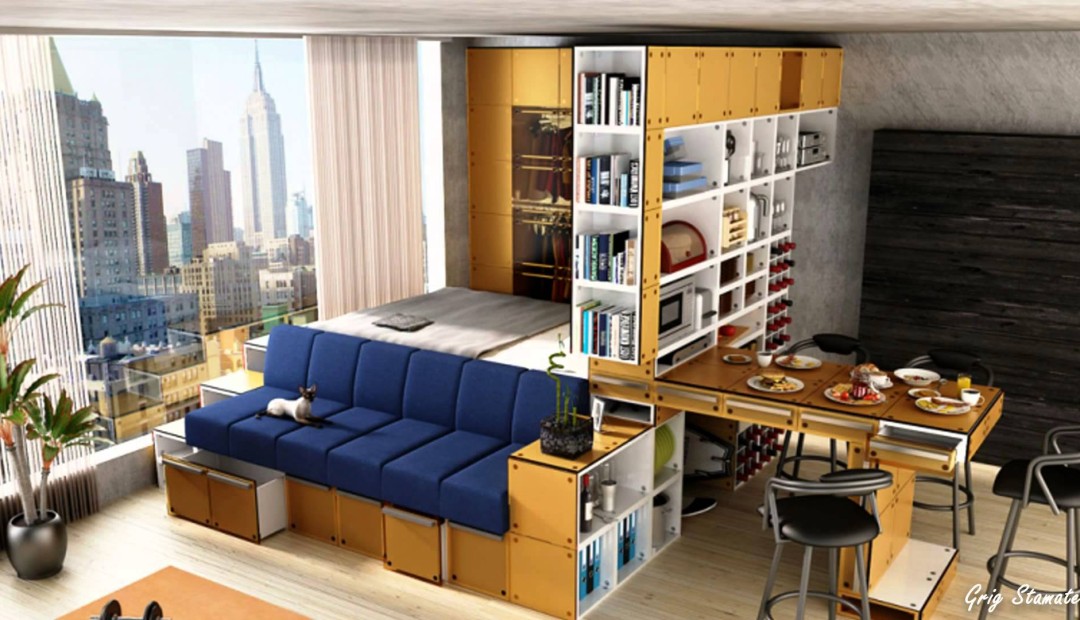
Whether or not you add physical dividers, every living area in your studio needs tonal separation. Your mind should sense some distinction between sleeping and dining areas, and color accents can do the trick.
For each separate space in your apartment, choose a subtle color and theme to make it psychologically distinct. As a whole, your apartment should flow together, but even little choices, like pairing a blue throw blanket on the couch with a ceramic bluebird on your coffee table, can separate each living area.
8. Hang pendant lamps.
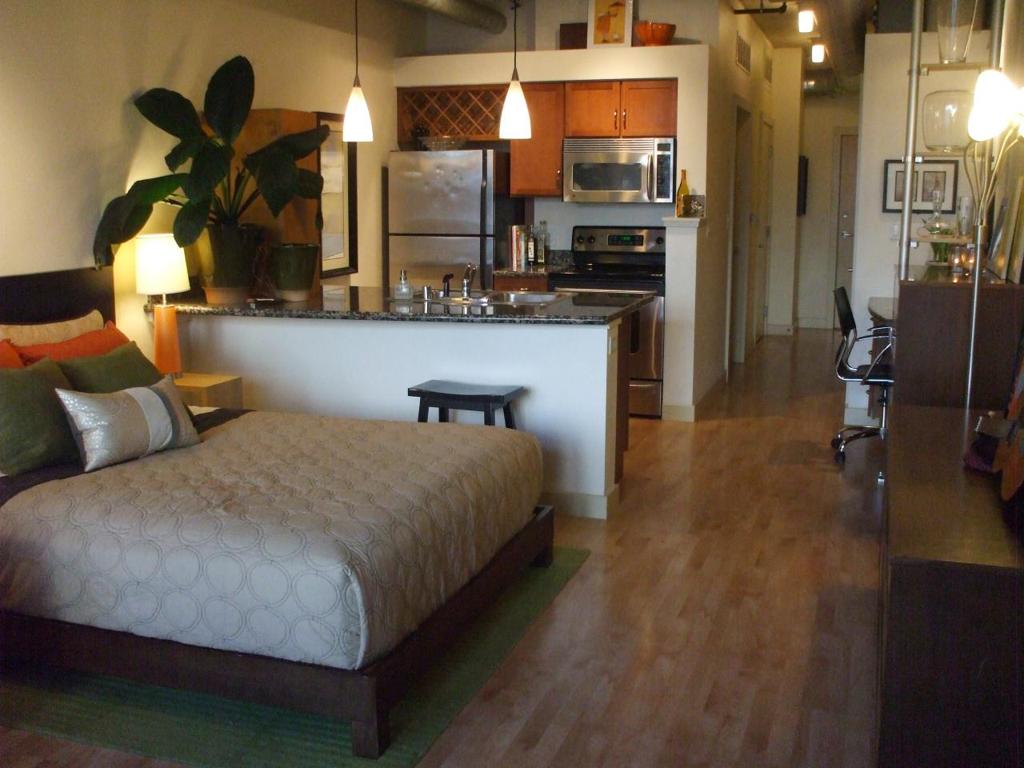
Because you need a well-lit apartment anyway, invest in some hanging pendant lamps to create another division. Not only do they save floor space because they hang from the ceiling, but pendant lamps are also easy to DIY.
Hang two or three strands of light to create an understated and practical barrier that separates your kitchen and dining area from your couch or bed.
Smart Furniture Placement
1. Multifunctional Furniture:
Investing in furniture that serves multiple purposes is essential for a studio apartment. A sofa bed provides seating during the day and a comfortable sleeping area at night.
Coffee tables with hidden storage or fold-out dining tables can maximize space and functionality. Look for pieces that offer flexibility and adaptability to meet your changing needs.
2. Zoning with Furniture:
Creating distinct zones with furniture placement helps organize your studio apartment effectively. Position your sofa away from your bed, creating a clear separation between the living and sleeping areas.
Use area rugs and lighting to define each zone further, making the space feel more structured and organized.
3. Floating Furniture:
Instead of pushing all the furniture against the walls, try floating some pieces, like a desk or a sofa, in the middle of the room.
This arrangement can create pathways, making the space more dynamic and less confined. Floating furniture can also visually help separate different functional areas within the studio.
4. Envision your floor plan, and don’t forget to include “doors.”
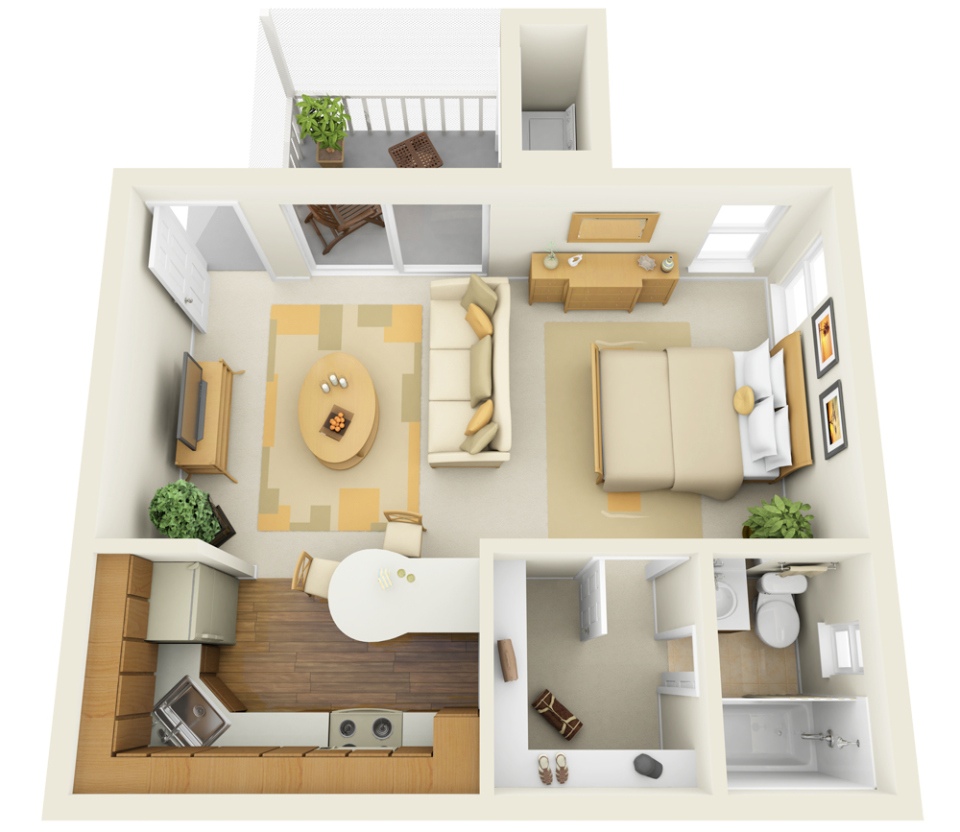
Before you even think about dividers, you should know the space you want to create. Decide which corners and areas of your studio will become your bedroom, living room, dining room, and kitchen.
Once you map this out mentally, begin grouping (or planning to buy) furniture that fits both the space and function of each area, and remember to include entryways. It may all begin in your head, but like any floor plan, it has to remain as accessible as possible.
5. Invest in a space-saving bed.
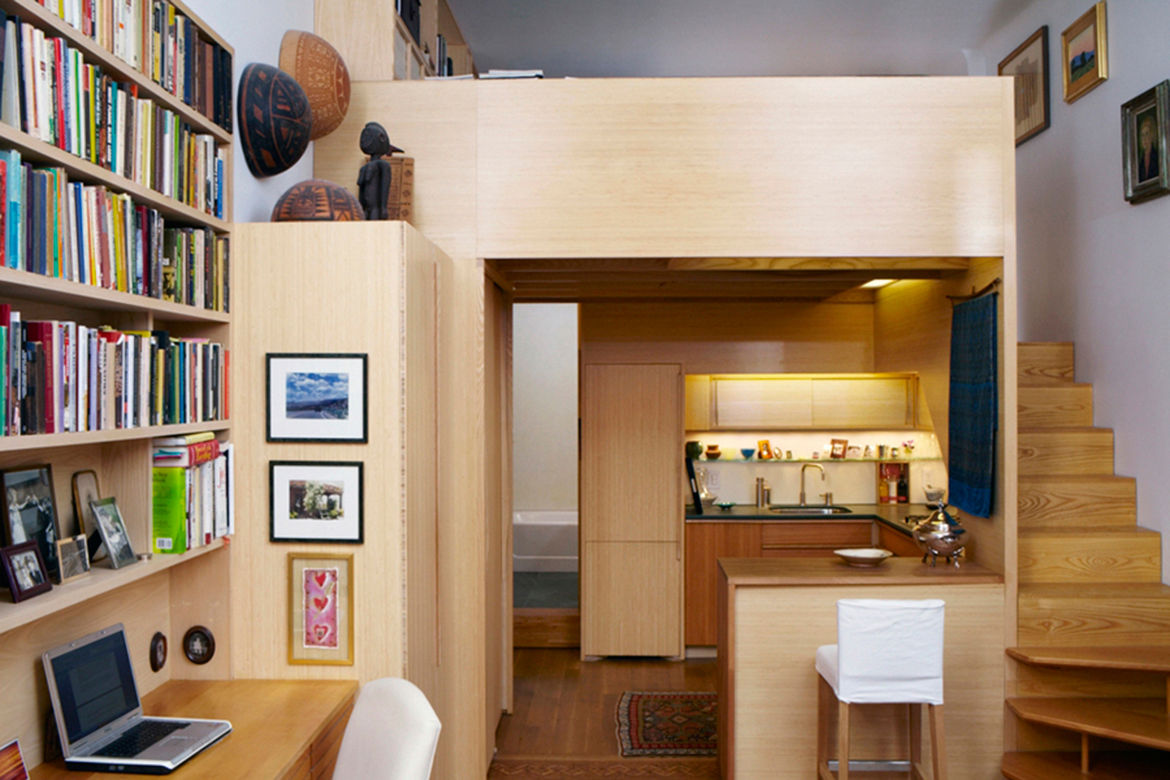
Maybe the best way to separate your sleeping quarters is by tucking them away, either against the wall with a Murphy bed or up near the ceiling with a loft bed. Both space-saving beds have their pros and cons, but either one would free up floor space for a living or dining area. Another plus: They can be ridiculously beautiful.
6. Create a floating closet.
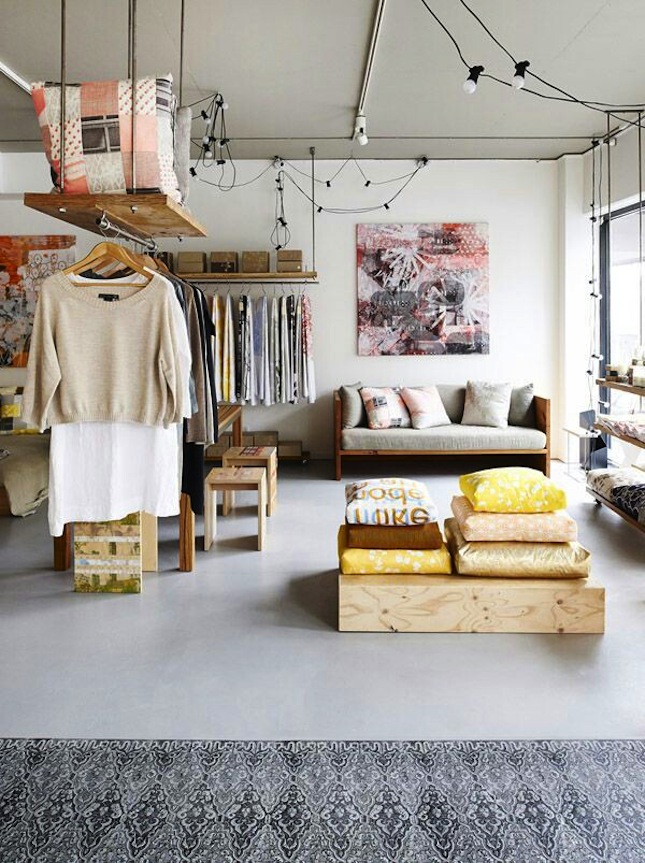
Unless you’re renting that rare unicorn of a studio apartment with four closets, you need a place to store your clothes as much as any other living area.
While you can send seasonal clothes off to storage, you still need to make space for the rest, and we suggest building a floating closet. Like the brilliant design above, floating closets can maximize storage space while adding a unique magical element to your tiny home.
Decluttering Techniques
1. Minimalist Approach:
Embracing minimalism involves keeping only essential items that bring joy or serve a purpose. Regularly declutter your belongings by donating or selling items you no longer need.
This approach helps maintain a clean, open, and serene living environment, making your studio apartment feel more spacious and less chaotic.
2. Hidden Storage Solutions:
Incorporating hidden storage solutions keeps clutter out of sight and maximizes available space.
Use under-bed storage boxes for off-season clothing, ottomans with secret compartments for blankets and pillows, and furniture with built-in storage for everyday items.
These solutions help keep your apartment tidy and organized without sacrificing style or functionality.
3. Clear out the clutter.
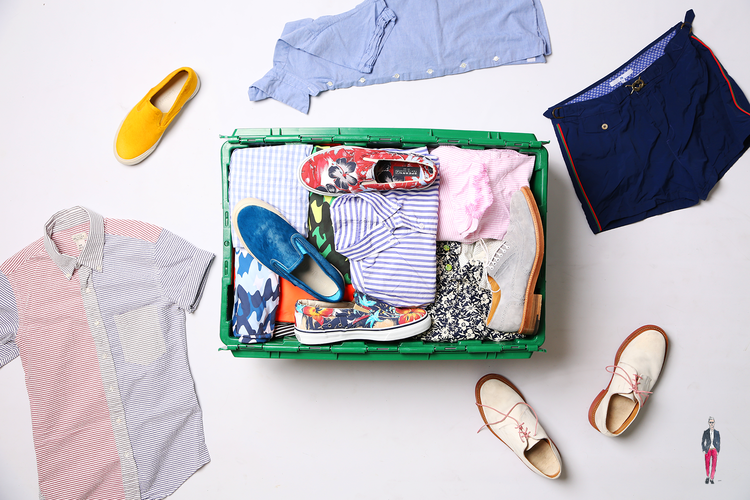
Fitting multiple living areas into one room is a tall order for anyone. The best designs and floor plans won’t amount to much if your studio is brimming with books, coats, and shoeboxes of old photos (here’s how to store old photographs without ruining them) and letters.
So as you plan how to divide your studio into separate rooms, be sure to also organize your apartment. Keep things that you need and/or make you happy; put the stuff that you love but don’t need right away in storage; and throw out, recycle, donate, sell, or gift the rest.
The result: a clean studio apartment with multiple customizable rooms in which you’re only surrounded by the objects that make you happy. And who wouldn’t want that?
Schedule a pickup with Clutter!
Conclusion
Optimizing a studio apartment involves creativity and strategic use of space. DIY projects and repurposed furniture add unique touches, while room dividers like curtains and bookshelves create distinct areas.
Decorative strategies such as accent walls and statement rugs enhance aesthetics. Clever furniture placement maximizes functionality, and decluttering techniques ensure a clean, organized environment. Combining these methods transforms your studio into a stylish, efficient, personalized living space.
FAQs for Studio Apartment Living
Q: How can I create distinct areas in my studio apartment?
Use rugs, lighting, and furniture placement to define separate zones. For example, place a rug under your bed to create a sleeping area and use a different rug in the living area. Floor lamps or hanging lights can also help delineate spaces, making each zone feel unique and purposeful.
Q: What are some space-efficient methods to divide a studio apartment?
Consider using curtains, folding screens, or open-back bookshelves to divide your space. These options are easy to install and can be moved or adjusted as needed, allowing you to create privacy and separation without taking up much room.
Q: What furniture can help with dividing space in a studio apartment?
Multifunctional furniture like sofa beds, storage ottomans, and fold-out desks can help create distinct areas while saving space. Tall bookshelves and room dividers with built-in storage are also great for separating areas and adding extra functionality.
Q: How can I effectively divide a large living room into two distinct rooms?
Use furniture such as sectional sofas or bookcases to create a physical boundary. Adding a large rug to each section and using different lighting for each area can help visually separate the spaces, making each feel like its own room.
Q: Are there any layout tips for organizing a studio apartment?
Optimize your studio layout by placing larger furniture along the walls to maximize open space. Use vertical storage solutions to keep items off the floor, and create clear pathways to maintain a sense of openness. Incorporate multifunctional furniture to enhance both organization and usability.
This article was written by David Michael McFarlane, a writer from Texas and Oregon who lives in New York and loves smart design and organization.


